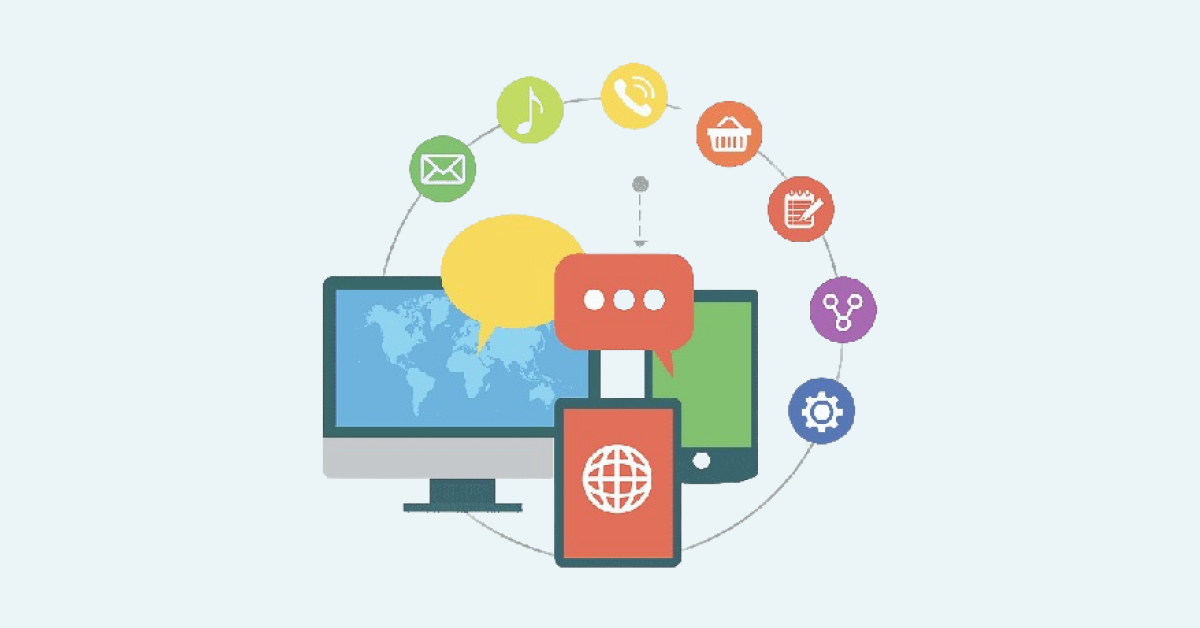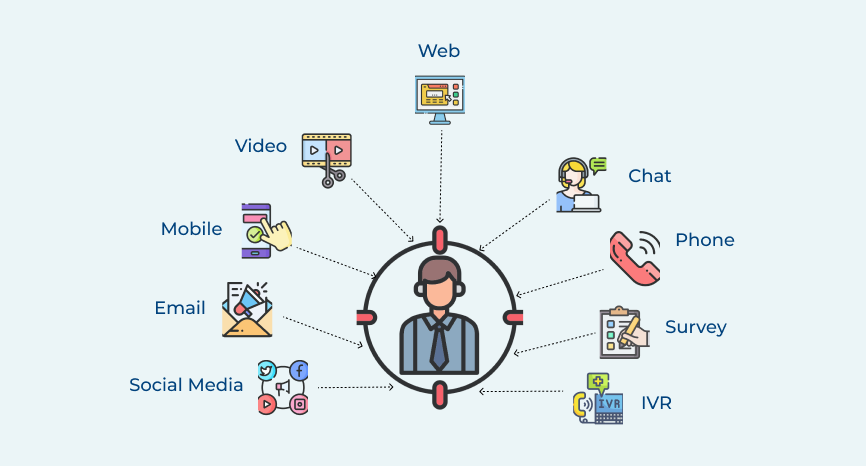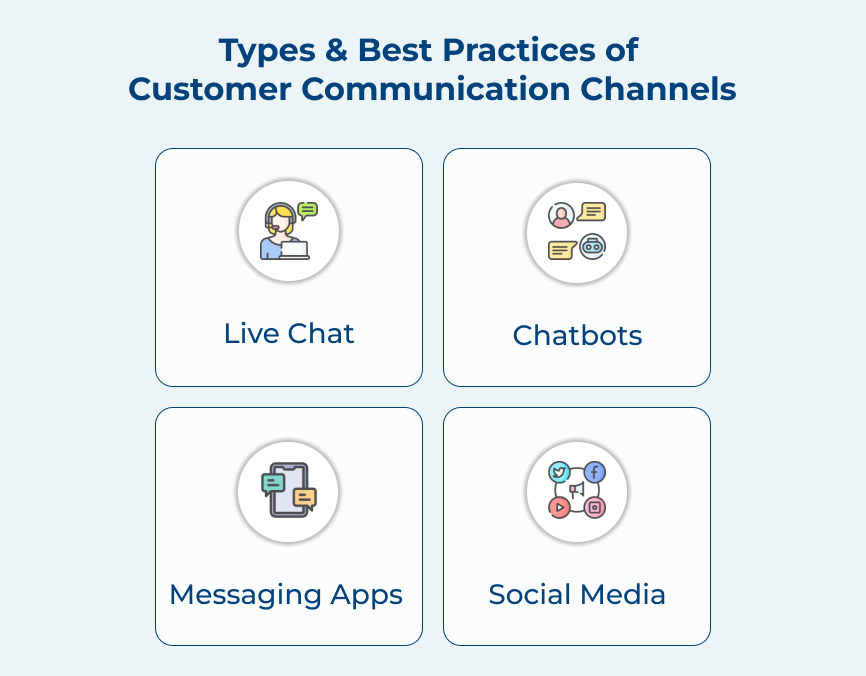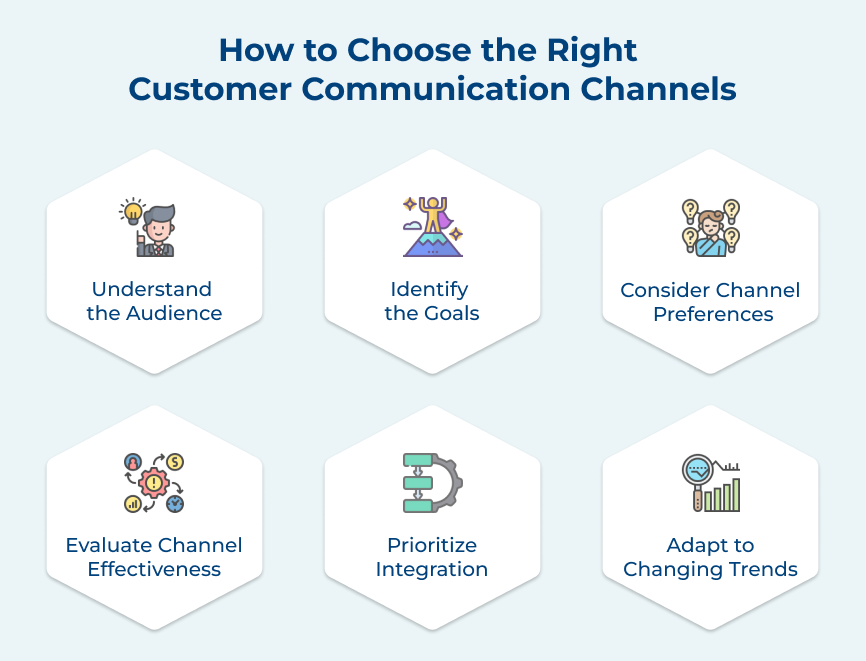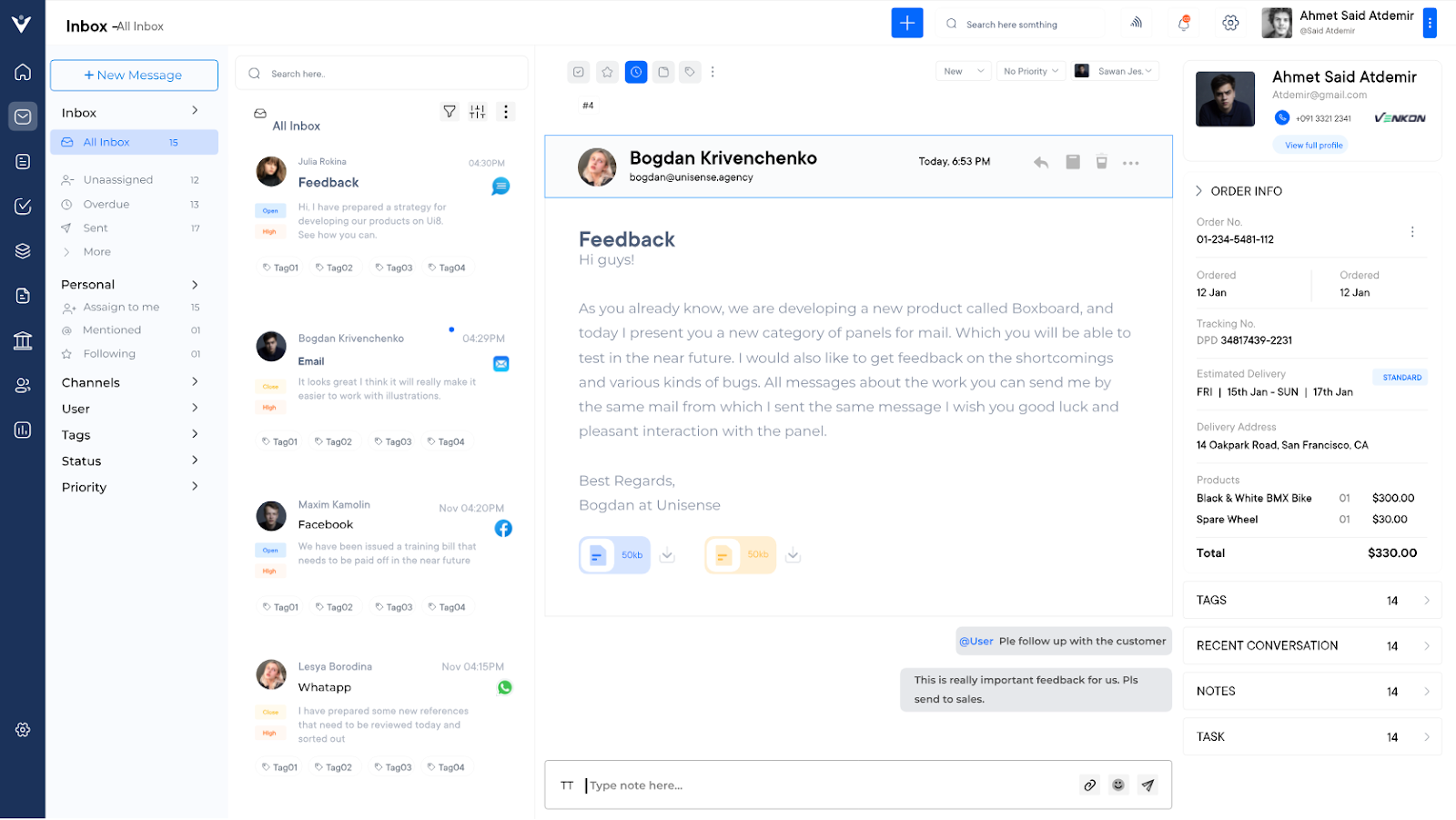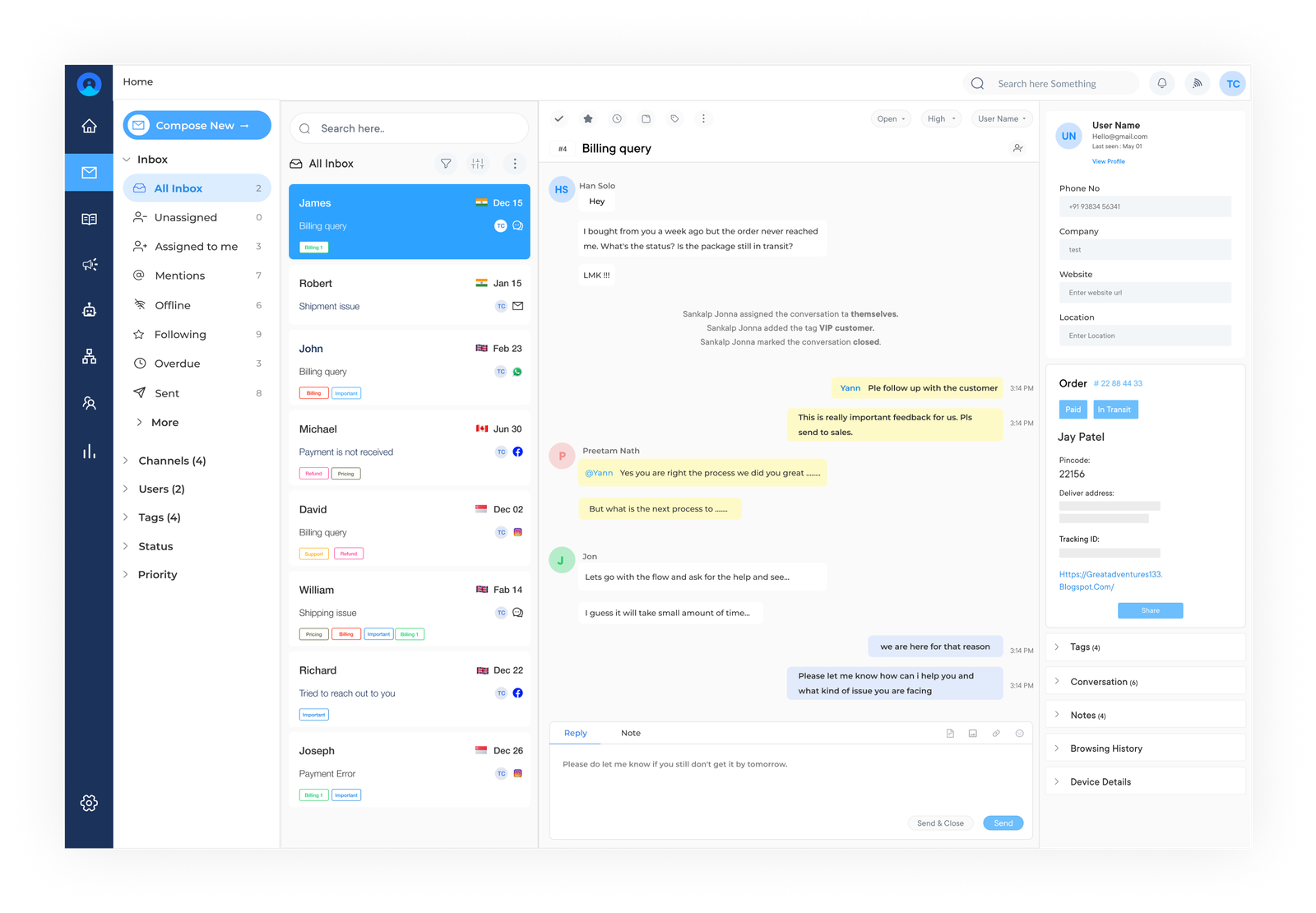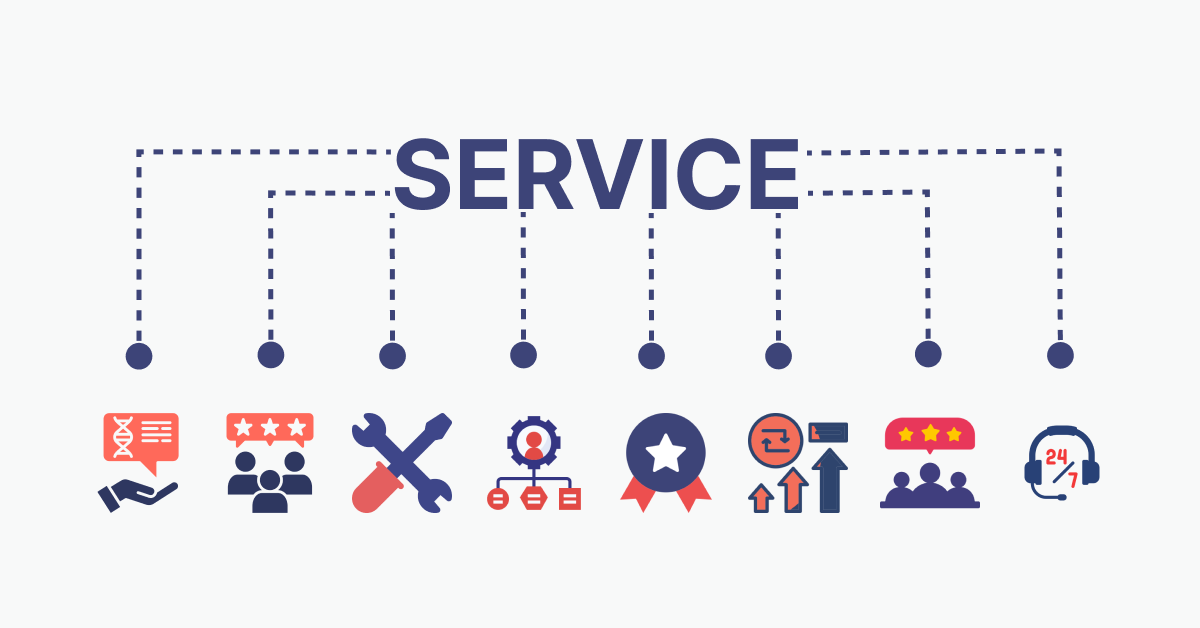A. Messaging Channels
Messaging-based consumer communication channels are becoming increasingly popular as they enable timely responses and provide avenues for two-way conversation. Below we have listed the the three most popular examples of messaging-based customer communication channels with customers:
1. Live Chat
Live chat has emerged as one of the best customer communication channels in recent years. It offers businesses a real-time and convenient way to connect with their customers, resulting in improved customer service and satisfaction. 51% of consumers are more likely to remain with or buy again from a company if the company offers a live chat support feature.
Live chat provides instant product support to customers, allowing them to ask questions, seek assistance, or resolve issues without having to make a phone call or send an email. It can significantly reduce customer frustration and provide a seamless experience. Brands can engage with customers on their websites, capture their attention and increase the chances of conversion.
Best practices:
- The live chat feature should be easily accessible on the website and appear on relevant pages.
- Response time should be quick and efficient, preferably under a minute. Customers value prompt assistance and delays can lead to dissatisfaction.
- Training and equipping live chat agents with the necessary resources is crucial.
2. Chatbots
Chatbots provide businesses with a round-the-clock customer support system. They are available 24/7, ensuring customers get prompt responses and their queries are addressed instantly. Such enhanced accessibility leads to higher customer engagement and loyalty.
The chatbot technology can efficiently handle large volumes of inquiries simultaneously, resulting in shorter response times and reduced customer waiting periods. It increases operational efficiency and customer satisfaction, as customers receive immediate assistance without any delay. They can be personalized to cater to specific customer needs.
Best practices
- Chatbots should be designed to converse in a natural and human-like manner, making the interaction more enjoyable for customers.
- The chatbots should have a clear understanding of when to escalate to a human agent, ensuring a seamless transition.
- Regular updates of the chatbot’s knowledge base are necessary to ensure accurate and up-to-date information is provided to customers.
3. Social Media
Social media provides a platform for businesses to connect with their target audience, build brand awareness and establish a strong online presence. Consistent sharing of engaging content can attract and retain customers, ultimately driving sales. Brands can also gather valuable insights about their customers through the likes, comments and shares they receive.
Social media enables direct and instant communication with customers. It facilitates real-time feedback, addresses queries and resolves issues promptly. Such a level of responsiveness helps build trust and loyalty, enhancing the overall customer experience.
Best practices
- Companies have to be consistent when it comes to posting high-quality and engaging content.
- Make sure to actively listen and respond to customer feedback or inquiries.
- Data analytics should be extensively leveraged to measure and optimize social media performance.
4. Messaging Apps
WhatsApp, Facebook Messenger and WeChat are renowned messaging apps that provide businesses with a direct line of communication with their customers. They allow for easy two-way communication to address queries, provide support and facilitate customer loyalty.
Messaging applications offer a more efficient and cost-effective alternative to traditional customer service methods. They enable businesses to handle multiple inquiries simultaneously, reducing response times and increasing customer satisfaction. Businesses can adopt a personalized approach by tailoring their messages and offers based on customer preferences.
Best practices:
- Respond promptly to customer inquiries, as delays can negatively affect customer experience.
- Personalize communication by using customer data to understand their needs and interests.
- Integrate messaging apps with other customer service platforms to provide a seamless and consistent experience across all channels.
B. Voice Channels
Voice channels are considered the best customer communication channel due to their ability to create personal connections and convey emotions effectively. Unlike other channels, voice allows customers to directly engage with a real person, providing a sense of trust and reassurance.
1. Phone/Call Center
A phone call adds a personal touch to customer interactions. It allows businesses to connect with their customers on a more personal level, facilitating trust and loyalty. The tone of voice, empathy, and responsive nature of a live conversation can greatly enhance the customer experience.
Phone calls serve as the option of delivering immediate problem resolution. Customers can quickly explain their issues, and your customer service representative can provide real-time solutions. It typically results in faster resolutions and increased customer satisfaction.
Pro tips:
- Use quality voice equipment so that the customers hear clear audio when they call in.
- Ensure the staff remains polite under all circumstances when communicating with a customer via telephone.
- Provide fast response times – answer every call within 2 rings so that customers don’t feel like their inquiry is being ignored.
2. Web Calling
Web calling is also known as VoIP (Voice over Internet Protocol) calling. It helps businesses to communicate with their customers in real-time through their websites or applications. It offers a convenient and cost-effective way to interact with customers, providing a personalized experience.
Web calling allows direct communication, reducing delays and improving customer satisfaction. Companies can enhance their brand image by offering seamless and professional customer service. Web calling also enables businesses to analyze call data and gain valuable insights to improve their overall communication strategy.
Pro tips:
- Offer users the choice between making a web call and other contact options like chat or email when they first enter the website.
- Give users the facility to talk directly with sales representatives should any questions need clarification before making a purchase decision
- Optimize the call routing process by utilizing intelligent AI routing tools that make sure the right caller connects with the right staff member at the right time.
C. Face-to-Face Channels
Face-to-face channels are widely regarded as the best customer communication channels due to their ability to establish personal connections and promote trust. The direct and personal approach allows for immediate feedback and a better understanding of customer needs, ultimately leading to enhanced customer satisfaction.
1. Video Chat
Video chat enables businesses to engage with their customers in a more personal and interactive way. It allows for face-to-face conversations, bridging the gap between online and offline experiences. The direct interaction facilitates trust and enhances the overall customer experience. 72% of companies report a greater amount of client collaboration via video conferencing.
Video chats are great alternatives to long meetings where everyone needs to travel (and pay for associated costs such as flights or hotels). They also provide an opportunity for remote teams or international clients to come together as one virtual team without having to physically meet up in person.
Pro tips:
- Schedule times ahead of time and make sure you have all relevant materials ready before taking your seat on the call.
- Try not to stress out over minor technical issues as software glitches can happen often. Develop a strategy involving multiple platforms if necessary.
2. In-Person Appointments
Businesses have numerous client communication channels with customers, but one channel that often gets overlooked but remains highly effective is in-person appointments. In-person appointments provide face-to-face interaction, allowing businesses to connect with customers on a more personal level.
In-person appointments are quite effective at building trust and credibility. When customers can interact with the business representatives directly, they feel more confident in the company and its offerings. There is always a better understanding of customer needs and preferences in such meetings.
Pro tips:
- Keep things on schedule by overbooking your day slightly. If something goes wrong with one appointment it can be covered better by minimizing delays.
- Be mindful that whatever impression you leave stays even beyond so take extra effort to appear conscientious and professional.
- Try asking questions related to current events which could indicate potential interests that could uncover opportunities for collaboration and partnerships.
D. Written Channels
Written channels are often considered the best option for businesses when it comes to customer communication channels. They allow for clear and concise messaging, ensuring that important information is delivered accurately. The practice provides a written record of communication, allowing for easy reference and documentation.
1. Email
Companies need a reliable and efficient channel to connect with their customers. While there are various options available, email remains the best channel for effective communication. It enables businesses to reach a large audience simultaneously, saving time and resources.
Using email as a customer communication channel helps in building customer relationships by delivering timely and targeted messages. Email campaigns can be customized based on customer preferences and behaviors to ensure relevance. It allows for easy tracking and analysis of customer responses, allowing businesses to measure their effectiveness.
Best practices:
- Businesses need to ensure relevance and avoid excessive frequency in their email communications.
- Personalized and customer-centric content should be prioritized to engage recipients.
- Implementing automation tools can help optimize email campaigns and track their success.
2. Knowledge Base
The knowledge case helps businesses by providing a centralized hub of self-service support. Customers can easily access articles, FAQs, tutorials and troubleshooting guides, reducing the need for constant customer support. Companies that offer a knowledge-based solution have seen a 20% increase in customer satisfaction.
Businesses showcase their expertise and establish themselves as thought leaders in their industry through a knowledge base. Offering informative content helps to build trust and credibility among their customer base.
Pro tips:
- Regularly review and update the content, so customers can access the most accurate information at all times.
- Review data from customer queries or utilize analytics tools to create more targeted content that’s tailored to their needs.
- Provide different ways of searching through the material (e.g., keywords, categories) so customers can easily find what they are looking for.
3. Survey forms
Survey forms are a cost-effective method for gathering customer data. They can be easily created and distributed online, minimizing the need for physical resources. The forms offer anonymity to customers, encouraging honest and unbiased feedback.
Businesses can fetch valuable information for making data-driven decisions. The collected data can be analyzed to uncover patterns, trends and areas needing improvement. It helps companies tailor their products, services, and marketing strategies to meet customer expectations.
Pro tips:
- Companies must ensure to keep surveys as short as possible.
- Providing an incentive for completing the survey can increase the rate of survey completion.
- Review responses regularly to determine improvements that should be made based on customer feedback.
E. Community Channels
Community-based client communication channels with customers provide an interactive platform where people from across the world can share ideas and develop relationships with each other and the brand.
1. Forums
Forums have emerged as one of the best customer communication community channels for businesses. The online platforms provide a space for customers to interact with each other, ask questions, share experiences, and provide feedback. It not only builds a sense of community but also promotes engagement and loyalty towards the brand.
Forums offer a unique opportunity to directly communicate with their customers. Actively participating in forums allows companies to gain valuable insights into customer needs, preferences, and pain points. It can inform product development, marketing strategies, and customer support initiatives.
Pro tips:
- Identify common topics or themes that customers may be discussing to provide timely answers to frequently asked questions
- Monitor conversations so you can quickly respond to any complaints or inquiries
- Create a checklist users must follow before posting new threads to keep conversations organized and spam-free.
2. Client Portal
One of the key benefits of a client portal is that it allows businesses to effectively manage and organize client-related documents. Contracts, proposals, invoices and project updates – everything can be conveniently accessed within the portal. It not only saves time but also ensures a seamless flow of information between the business and its clients.
A client portal promotes transparency and builds trust. Clients can easily track the progress of their projects, access important documents, and communicate with the business in real-time. The level of transparency strengthens the relationship between the business and its clients, leading to better customer satisfaction.
Pro tips:
- Automate onboarding processes so users understand their responsibility in maintaining account information
- Train agents regularly on new features or procedures related to the client portal support.
- Keep usability at the top of your mind when creating/updating portals. Think of simple navigation paths and uncomplicated content sliders.
How to Choose the Right Customer Communication Channels
Check out the key considerations to help you choose the most effective communication channels for your business, ensuring you connect with your customers on the right terms.
